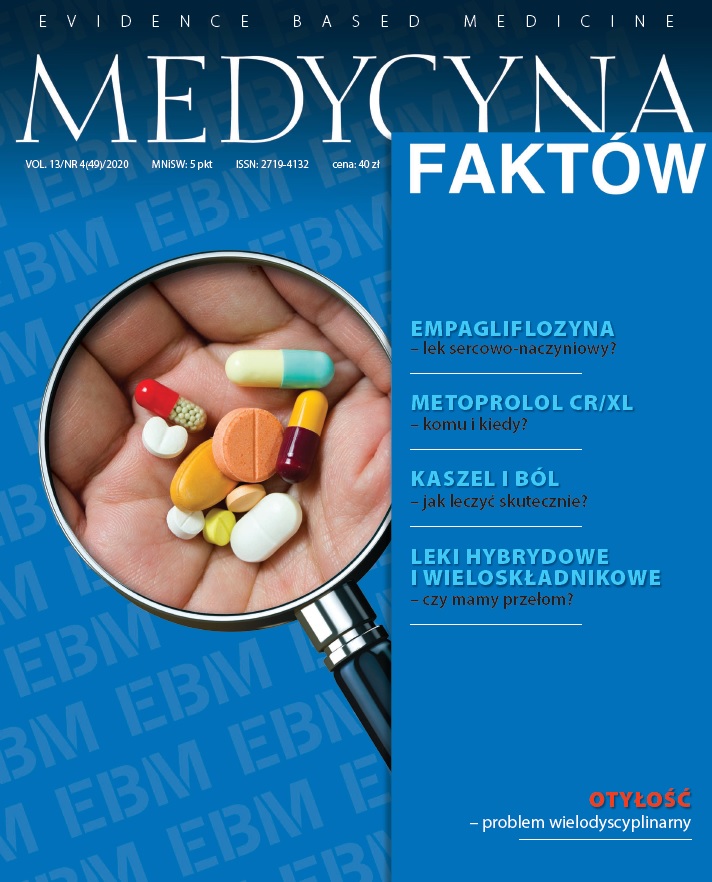What after a myocardial infarction? Exponentiation of our knowledge. Satellite session by Berlin-Chemie/Menarini. Congress of the Polish Cardiac Society 2020 Meeting Proceedings
Main Article Content
Abstract
In the 21st century, preventive measures are obvious and widespread. They apply to virtually every branch of medicine, particularly to cardiology. A healthy, balanced diet, maintaining proper body weight, and regular physical exercise – a so-called primary prophylaxis – significantly reduce the risk of cardiovascular diseases. However, if the development of atherosclerosis cannot be prevented and the patient develops acute coronary syndrome, secondary prophylaxis should be introduced. In this group, in addition to constantly encouraging and motivating people to live a healthy lifestyle, it becomes necessary to implement appropriate, targeted pharmacotherapy. Selecting the right set of medications for such patients improves not only long-term prognosis but also the quality of life, without causing side effects. In some cases, however, even the best secondary prophylaxis will not prevent the patient from developing the complication of symptomatic heart failure. Even then, prophylaxis should be applied, by implementing a well-tolerated diuretic, which taken regularly, allows to reduce the number of hospitalizations due to heart failure.
Article Details
Copyright © by Medical Education. All rights reserved.
References
2. Wytyczne ESC dotyczące prewencji chorób układu sercowo-naczyniowego w praktyce klinicznej – 2016 rok. Kardiol Pol. 2016; 74(9): 821-36.
3. Wytyczne ESC dotyczące rozpoznawania i leczenia przewlekłych zespołów wieńcowych – 2019 rok. Zeszyty edukacyjne. Kardiol Pol. 2020; 1.
4. Machura M, Hudzik B, Gąsior M. Mechaniczne powikłania zawału serca. Folia Cardiol. 2017; 12(6): 565-9.
5. Flachskampf FA, Schmid M, Rost Ch et al. Cardiac Imaging after myocardial infarcion. Eur Heart J. 2010; 32(3): 272-83.
6. Antoni ML, Mollema SA, Delgado V et al. Prognostic importance of strain and strain rate after acute myocardial infarcion. Eur Heart J. 2010; 31(13): 1640-7.
7. Eitel I, de Waha S, Wöhrle J et al. Comprehensive prognosis assessment by CMR imaging after ST-segment elevation myocardial infarction. J Am Coll Cardiol. 2014; 64(12): 1217-26.
8. Wytyczne ESC/EACTS dotyczące rewaskularyzacji mięśnia sercowego – 2018 rok. Kardiol Pol. 2018; 76(12): 1585-664.
9. ESC Guidelines for the management of cute coronary syndromes in patients presenting without persistent ST-segment elevation – 2020. Eur Heart J. 2020; ehaa575.
10. An EAPCI Expert Consensus Document on Ischaemia with Non-Obstructive Coronary Arteries in Collaboration with European Society of Cardiology Working Group on Coronary Pathophysiology & Microcirculation Endorsed by Coronary Vasomotor Disorders International Study Group. EuroIntervention. 2020. Online head of print.
11. Kozłowska B, Leszek P, Niedziela J et al. Clinical characteristics and treatment profiles of patients after acute myocardial infarction with left ventricular ejection fraction below 40%: a short 2018–2019 report on the PL‑ACS registry. Kardiol Pol. 2020; 78(7-8): 766-9.
12. Wytyczne ESC dotyczące diagnostyki i leczenia ostrej i przewlekłej niewydolności serca – 2016 rok. Kardiol Pol. 2016; 74(10): 1037-47.
13. Sesja satelitarna firmy BerlinChemieMenarini (access: 10.11.2020).

